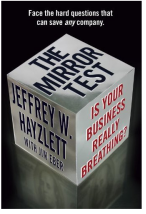
Photo credit hayzlett.com
Jeffrey Hayzlett is the former CMO at Kodak and author of “The Mirror Test: Is Your Business Really Breathing?”. You might have seen him on Celebrity Apprentice with Donald Trump or speaking at a variety of industry conferences. He hails from South Dakota and considers himself a cowboy. Unfortunately, I couldn’t find any photos of him online with a cowboy hat.
I connected with Jeff yesterday morning to talk about his success with social media, corporate change, Kodak, ROI and his upcoming keynote presentation at SES San Francisco.
Jeff, it was great to finally “meet you” on the Beancast recently and thank you for inspiring the idea behind a pretty popular blog post “Why Do So Many Companies Suck at Social Media” which has had well over 1,100 retweets and multiples of that in page views.
Why do you think companies are having a hard time with social media?
I think most companies just don’t understand it. There are some fundamental conflicts that they have. The biggest piece about social media is listening. That’s it. It’s listening to customers. A lot of companies just don’t get it.
Companies have outsourced everything. They’re outsourcing their contacts with their customers, which quite frankly, I don’t get. My own company that I worked for had done the same thing. I didn’t appreciate that, didn’t like that and didn’t like the way in which we did it. Those decisions weren’t necessarily mine, but I tried to impact those decisions.
I think a lot of companies really suck at this social media stuff because they don’t get the listening part. They’re afraid. Therefore, when they become afraid, they’re a little worried about giving up control. That’s what they think they’re doing with social media.
The thing is, they never had control to begin with. The customers always had control. That’s the way it’s always been. As these companies start to enter into this, they’re just not very good at listening and you have to get good at listening first.
It’s a mind shift isn’t it?
It is a mind shift. Either you’ve “got it or you don’t”. Eventually I think they can get it. I think one third of the companies will get it right away, about one third will eventually get it and about one third will never get it.
It sounds similar to leadership. Some people have it, some people can learn it and some people never will.
I think confidence is another word to use. Are you confident in what you do and how you do it?.

Photo credit: hayzlett.com
You’ve been called a Celebrity CMO by Forbes Magazine and I think it’s fair to say you’re a great example of a senior marketing leader that “walks the talk” when it comes to social media: personally, what you’ve done at Kodak and in promoting your book, “The Mirror Test”. What advice do you have for other business and marketing leaders who are deciding their own level of engagement on the social web?
I think the most important thing is just to be genuine, be real. Social media is a very transparent thing, so you can’t fake it. I am who I am and I don’t try to be anything else. I don’t try to change my tweets or do things diferently than what you see on Facebook. It’s me, it’s who I am.
Yesterday I was talking to some folks from Kareem Abdul Jabbar about an upcoming project and I said, how cool is this? My job: I’m talking to Kareem Abdul Jabbar! I grew up watching this guy and the Lakers.
I think about things like that and who I am. I think most people who are in this game, who are really good, besides the “celebrity” portion of it, a lot of folks are and that helps them to gain notoriety. But the guys who are really good at it are the people who share, who are open and genuine. You get a good sense of who they are and I think that’s very helpful. That’s who I am.
My team members will tell you, you’ll never have to second guess me when it comes to something, because I’m going to tell you exactly what I’m thinking whether it’s right or wrong. Sometimes I even say things that are incorrect, politically or just downright wrong, because I don’t know what I don’t know. But I’m also willing to say, “I don’t know. Or wow, let’s go back and change that.”
How much of a change agent do large corporate marketers need to be in order to get their companies to see the value of social web participation?
Regardless of the social web, I think marketing’s job, and the head of marketing more than anybody, is to cause tension in the organization. My former CEO said that was my main job. When he explained that to me, it made a lot of sense and I’ve really taken up that mantra. That was my job at Kodak and it led me to be the big change agent in the company, which is what I was hired to do.
Everybody else had to be change agents as well. A big part of what I was supposed to do was cause that change and tension. I think for leaders reading this, you’re job is not unlike that of a marketer, to put a little tension in between organizations, between old ideas and new ideas. Because from that tension you get a lot of good things.
There’s an old saying in sports, “No pain, no gain.” I think the same thing holds true here in business. You don’t want the pain, but you want the tension. That’s what brings about better decisions and better actions.
 The blogging done by Kodak with Jenny Cisney and team has been cited as a best practice by numerous publications, bloggers and as an example at conferences. Do you think most companies should blog?
The blogging done by Kodak with Jenny Cisney and team has been cited as a best practice by numerous publications, bloggers and as an example at conferences. Do you think most companies should blog?
Yes, absolutely. I think they should blog. The key thing is, “who” should blog? We named the very first Chief Blogger ever. We also named the first Chief Listener as part of our social media team.
A lot of people thought I had a lot of input into the blog, what we did, how we said it and direction, but I didn’t. I setup a Blog Communications Council. My head of communications headed it up as the publisher, pretty much like a newspaper model. Jenny as chief blogger became the chief editor and she coordinated all the other bloggers that worked for her kind of like reporters.
That’s the only structure I wanted to see happen around it, plus the mood and theme. Outside of that, I never saw a blog post until after it was published. I allowed my teams to go with the way they wanted to go, except for a few times when linking out to something risque. We still referenced it, but took the link down. We did things like that to respect the values of our employees.
A lot of companies make big mistakes and say, “I think the CEO is the one that should blog for us”. I think that’s the last person I’d want to talk to mostly in the company, because they’re usually not that exciting.
You want to think about who you want to have blogging and they way you want to do it. In fact, Kodak has a great social media policy book that’s out on how to get into all this. It’s free on their website at: Kodak Social Media Tips (pdf).
How do you define success with social activities like blogging?
You can talk about how many people refer back, visitors and so on. I’m not so interested in the eyeballs and ears. I’m more concerned about participating with hearts and minds. So building out a community that really likes you.
You can syndicate out blog content and drive more attention because ultimately you want more people to take a look at you and get a sense of who you are.
We wanted to be uplifting and helpful to our customers with hints, tips and things like that. Reflect our culture and the mood of our company and also represent our product very well. We also wanted to blog for our employees which is a big part of our community. I think employees look at your blog as much as anybody else.
There’s a lot of companies looking at social activities, blogging included. They’re considering measures of success and it makes sense, you had a goal of better engaging with customers, telling your story and connecting with employees. Obviously metrics would follow along those goals.
I think blogs should be an extension of you, not necessarily the official mouthpiece. I think blogs should reflect your personality more than the corporate position on this or that. People will appreciate that more.
The acronym ROI means something different for you (Return on Ignore) can you elaborate on that? How do you answer the Return on Investment question with large company social media efforts?
There are three types of Return on Investment I’m measuring all the time:
- Increase in sales
- Increase in margin
- Increase in customer satisfaction
Those are the three most important ROI things I’ve got to deliver and concentrate on the most. The rest of it’s just keeping track of stuff.
I said the “Return on Ignore” statement in a way to cause tension, which is what I’m known for. We spend so much time trying to measure the things we’re doing rather than the real things which is about listening to our customers.
I can’t say enough how important it is to listen to your customers because its about capturing customer behaviors that drives your sales, margins and satisfaction.
Those are the things that are the most important. How about paying attention to your customers more and less about what percentage of the customers we’re reaching at any particular time and micromanaging down to the nit on every single email campaign or whatever. People spend a lot more time than they need to on trying to figure out ROI. They want to put a dollar amount on everything you do to measure it and you can’t do it. You’ll spend your entire career and never get it done.
 Your book, the Mirror Test is doing well and has the endorsement of people like Donald Trump and Christie Hefner. Can you share more about the 3 tests you talk about in the book?
Your book, the Mirror Test is doing well and has the endorsement of people like Donald Trump and Christie Hefner. Can you share more about the 3 tests you talk about in the book?
There are a lot of tests in the book , but the three main themes of tests are:
Look in the mirror – Are you breathing? Does the dog eat the dog food? Does the idea that you have warrant merit? Will it breathe? Will it fog the mirror? There’s that piece of it we have to ask ourselves because passion alone is not a substitute for good planning and proper steps in terms of marketing and having a great business idea.
Looking in the mirror at yourself – Do I have what it takes? Do my people have what it takes? Looking around the business itself and does it look like a winner. Because sometimes we get caught in a rut and you need to walk into HQ once in a while and change it up.
Bottome line: Am I making money? – This is the most important one. Because in the end, it’s about generating profit. Ultimately that’s what businesses are supposed to be doing so you can do everything else you want to do in your life whether it’s personally or invest back into the business.
My conditions for satisfaction and success are: Grow wealth for my family, grow professionally and have fun doing it.
It was time for me to leave at Kodak because I had done what I was supposed to do and completed it. Now it’s time for me to go on to the next chapter and do something else. I stayed at Kodak for 4 years and 1 month. That’s the longest I’ve ever stayed anywhere and a lot longer than most CMOs out there. It was time for me to move on. Those are my personal tests myself, that I must be able to live up to.
A lot of people have said, “Why would you leave Kodak?”. You’ve got corporate jets, you’ve got this you’ve got that, and it was a great kind of a gig. I’m so grateful and I love the company. It was time for Jeff Hayzlett to do something different.
“Adapt or die” is a strong theme of the book. Those words are easier said than implemented. What advice do you have for tradition-rich organizations to see the value of change?
I think that should be part of their mantra and part of their DNA. A company like Kodak forgot that it was an innovative company. It forgot that it had 25,000 patents in the world. It forgot that it was inventing things. It forgot it took materials science and imaging science and put them together and created unbelieveable products. It started thinking of itself only as a film company.
What that did is contain itself in a little yellow box. And it was much bigger than the yellow box. What they needed was some people from the outside to remind them, no you’re really about creating the box, creating new boxes and creating things that go inside the box. That’s what you’re about.
You create emotional technology that helps people to make, manage and move images and information. That’s what you do. You’re not a film company, not a camera company and not commercial printing company. You’re an innovative company that creates emotional technology.
So, now what does that open up for you? It opens your horizons to a whole different way of thinking.
 You’ll be keynoting at SES San Francisco in a few weeks. Can you give us a little preview of what you’ll be talking about?
You’ll be keynoting at SES San Francisco in a few weeks. Can you give us a little preview of what you’ll be talking about?
Well, it’s going to be exciting, first of all! There’s no telling what I’m going to be talking about at this particular event because I’m always different everywhere I go.
I will be talking about transformation and change and how search engine optimization and search engine strategies fit in to that. And how you’ve got to be thinking about that as you put together everything you do.
I don’t think it’s always at the forefront of everyone’s thoughts. For marketers, for the most part it’s an afterthought, not a forethought. So imagine redesigning your sites in different ways to make sure your optimization and being searchable is better as you put things together.
So it’s going to be talking about strategy. It’s about the use of strategy and how you come up with products and services and offer them up on the web to get you noticed more. That’s going to be key, especially as we move more into video. Beyond that, is, what is this industry going to be doing around mobile?
Lee: We’re really looking forward to it.
It’s going to be a blast, it’s a great crowd, a great conference. It’s one that I’ve been wanting to do for a long time and they finally got around to calling me 🙂
At SES I’m moderating a panel called “Selling Search Marketing to the C-Suite”. Can you share a tip that I might include in the presentation that helps internal marketers do a better job of communicating the value of search marketing to business leaders?
Two things. One, I write about this in my book The Mirror Test, ways how to reach C-Level executives. I always find it interesting, people say, “I’d really like to meet with you” and so I say, “OK, so call me”.
I will tell you that the higher you get up in the organization, the lonelier it is. Even though you’re busy busy busy. Before 8 and after 5, I answer my own phones and it’s amazing who calls and who doesn’t call. And that there are people who want to reach you, but never reach out to you.
The biggest thing I’d tell you is what’s your elevator pitch? I redefine the elevator pitch in the book, The Mirror Test. It’s probably one of the biggest concepts that’s come out of the book, called the 118. And what I mean by that is 8 seconds is the average attention span of an adult. I know it to be true because I looked it up on the internet :).
And then 110 seconds is the average elevator ride in New York City from the time you press the button, step on the elevator, ride up or ride down and get off. So that’s what you have to pitch me.
You have 8 seconds to hook me to get that lean-in factor, so that I want to pay attention to you. And then 110 seconds to close me.
In that 110 seconds, don’t tell me who you work with, because I could care less. Talk to me about the value you’re going to create for me, the pain points you’re going to solve. What is your unique selling proposition that stands out above everybody else. Otherwise, don’t talk to me, don’t waste my time.
I want to hear in 118 seconds or less, what you’re specifically going to do for my company. And don’t give me some generic crap that you would give to somebody else. I want you to do your homework. I want you to look at my company, find out about me and show me.
Imagine if you walked up to me and said, “I did a profile on your company and I can show you 3 ways that will add $X to your bottom line if you implement one tool. Would you be interested?”
Well, man if I head a pitch like that, it’s going to make me pay attention. It means you’ve done your homework, you’ve researched me. You’ve invested in me and gone out of your way to prepare a presentation that shows I’m not doing it as good as I could. And if I used you, I could gain. You gain, I gain. That’s a pretty good deal. I’ll guarantee you most people will not come up with that kind of approach.
Thanks Jeff!
You can see Jeff give a keynote presentation at the upcoming Search Engine Strategies conference in San Francisco on Tuesday, August 17th at 9am. You can find out more about Jeff’s book The Mirror Test and his CEO Network on his website. You can also find him on Twitter.


